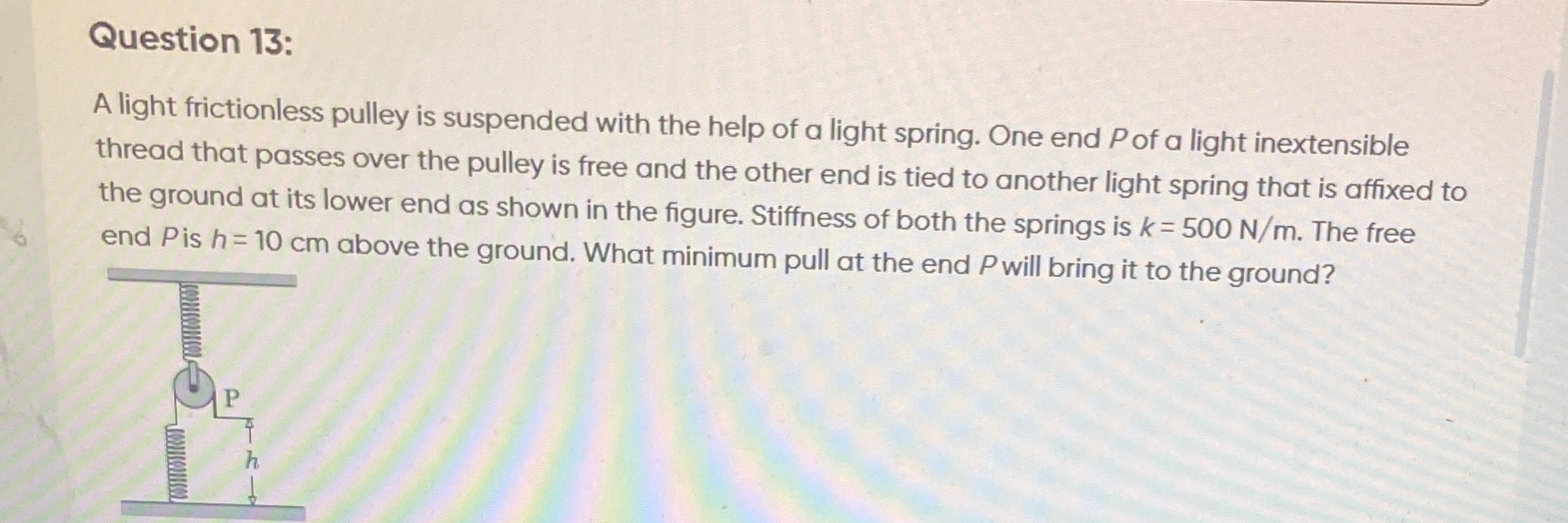Question
Question: A light frictionless pulley is suspended with the help of a light spring. One end $P$ of a light ine...
A light frictionless pulley is suspended with the help of a light spring. One end P of a light inextensible thread that passes over the pulley is free and the other end is tied to another light spring that is affixed to the ground at its lower end as shown in the figure. Stiffness of both the springs is k=500 N/m. The free end P is h=10 cm above the ground. What minimum pull at the end P will bring it to the ground?

10 N
Solution
Let k be the stiffness of the springs and h be the initial height of point P from the ground. Let T be the tension in the thread. Let xu be the extension of the upper spring and xl be the extension of the lower spring.
In equilibrium, for the pulley: kxu=2T. For the lower spring: T=kxl. Combining these, we get kxu=2(kxl), which implies xu=2xl.
Let ypulley be the height of the pulley from the ground and yattach be the height of the attachment point of the lower spring from the ground. The total length of the thread L can be expressed as: L=(ypulley−yattach)+(ypulley−h)=2ypulley−yattach−h.
Let Y be the height of the fixed support of the upper spring, and Lu,Ll be the natural lengths of the upper and lower springs, respectively. ypulley=Y−(Lu+xu) yattach=Ll+xl Substituting these into the expression for L: L=2(Y−Lu−xu)−(Ll+xl)−h L=2Y−2Lu−2xu−Ll−xl−h Using xu=2xl: L=2Y−2Lu−2(2xl)−Ll−xl−h=2Y−2Lu−Ll−5xl−h.
When a pull F is applied at P, the tension becomes T′=T+F. The new extensions are xu′ and xl′, and the new height of P is h′. The force equations are kxu′=2T′ and T′=kxl′, so xu′=2xl′. The new length of the thread is L=2ypulley′−yattach′−h′, where ypulley′=Y−Lu−xu′ and yattach′=Ll+xl′. L=2(Y−Lu−xu′)−(Ll+xl′)−h′ L=2Y−2Lu−Ll−5xl′−h′.
We want to find the minimum pull F that brings P to the ground, so h′=0. L=2Y−2Lu−Ll−5xl′. Equating the initial and final expressions for L: 2Y−2Lu−Ll−5xl−h=2Y−2Lu−Ll−5xl′ −5xl−h=−5xl′ 5xl′=5xl+h xl′−xl=h/5.
The pull F is the increase in tension: F=T′−T=kxl′−kxl=k(xl′−xl). Substituting xl′−xl=h/5: F=k(h/5).
Given k=500 N/m and h=10 cm =0.1 m. F=(500 N/m)×(0.1 m/5)=500×0.02=10 N. The minimum pull required is 10 N.
